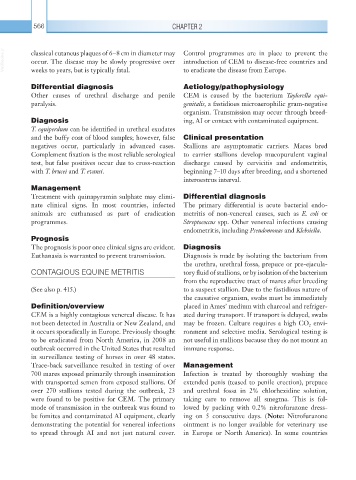Page 591 - Equine Clinical Medicine, Surgery and Reproduction, 2nd Edition
P. 591
566 CHAPTER 2
VetBooks.ir classical cutaneus plaques of 6–8 cm in diameter may Control programmes are in place to prevent the
introduction of CEM to disease-free countries and
occur. The disease may be slowly progressive over
to eradicate the disease from Europe.
weeks to years, but is typically fatal.
Differential diagnosis Aetiology/pathophysiology
Other causes of urethral discharge and penile CEM is caused by the bacterium Taylorella equi-
paralysis. genitalis, a fastidious microaerophilic gram-negative
organism. Transmission may occur through breed-
Diagnosis ing, AI or contact with contaminated equipment.
T. equiperdum can be identified in urethral exudates
and the buffy coat of blood samples; however, false Clinical presentation
negatives occur, particularly in advanced cases. Stallions are asymptomatic carriers. Mares bred
Complement fixation is the most reliable serological to carrier stallions develop mucopurulent vaginal
test, but false positives occur due to cross-reaction discharge caused by cervicitis and endometritis,
with T. brucei and T. evansi. beginning 7–10 days after breeding, and a shortened
interoestrus interval.
Management
Treatment with quinapyramin sulphate may elimi- Differential diagnosis
nate clinical signs. In most countries, infected The primary differential is acute bacterial endo-
animals are euthanased as part of eradication metritis of non-venereal causes, such as E. coli or
programmes. Streptococcus spp. Other venereal infections causing
endometritis, including Pseudomonas and Klebsiella.
Prognosis
The prognosis is poor once clinical signs are evident. Diagnosis
Euthanasia is warranted to prevent transmission. Diagnosis is made by isolating the bacterium from
the urethra, urethral fossa, prepuce or pre-ejacula-
CONTAGIOUS EQUINE METRITIS tory fluid of stallions, or by isolation of the bacterium
from the reproductive tract of mares after breeding
(See also p. 415.) to a suspect stallion. Due to the fastidious nature of
the causative organism, swabs must be immediately
Definition/overview placed in Ames’ medium with charcoal and refriger-
CEM is a highly contagious venereal disease. It has ated during transport. If transport is delayed, swabs
not been detected in Australia or New Zealand, and may be frozen. Culture requires a high CO envi-
2
it occurs sporadically in Europe. Previously thought ronment and selective media. Serological testing is
to be eradicated from North America, in 2008 an not useful in stallions because they do not mount an
outbreak occurred in the United States that resulted immune response.
in surveillance testing of horses in over 48 states.
Trace-back surveillance resulted in testing of over Management
700 mares exposed primarily through insemination Infection is treated by thoroughly washing the
with transported semen from exposed stallions. Of extended penis (teased to penile erection), prepuce
over 270 stallions tested during the outbreak, 23 and urethral fossa in 2% chlorhexidine solution,
were found to be positive for CEM. The primary taking care to remove all smegma. This is fol-
mode of transmission in the outbreak was found to lowed by packing with 0.2% nitrofurazone dress-
be fomites and contaminated AI equipment, clearly ing on 5 consecutive days. (Note: Nitrofurazone
demonstrating the potential for venereal infections ointment is no longer available for veterinary use
to spread through AI and not just natural cover. in Europe or North America). In some countries

